|
A glimpse into the past...
August 11, 1932.
Injury from grasshoppers, army worms, Hessian flies, and chinch bugs
has been spotted in various locations in the state. Demonstrations in
burning to destroy the bugs will be given in southern Iowa this fall.
July 6, 1933.
Farmers in battle with chinch bugs.
May 17, 1934.
Chinch bugs are found all over Keokuk Co. The migration into corn
fields will start in June. Demonstrations for control will be given.
Control consists largely of building oil barriers. The young bugs can't
fly and the oil barrier is a good way to control them if properly
attended to. Farmers can investigate the degree of infestation by
digging around the roots of oats and wheat in the morning or look
closely as they crawl on the surface during the heat of the day.
March 21, 1935.
Dust storms of last week have been causing illness over a wide area. In
Keota numerous cases of sore throat and high fever which doctors
attribute to some dust borne infection are reported.
July 1, 1937.
Poison bait is being distributed at the mixing station at Sigourney and
the poisoning campaign in Keokuk is now under way. Heavy kills are
reported by farmers who use the bait which is furnished by federal and
state government to kill grasshoppers.
November 25,
1937. The Community Club has completed arrangements for the Corn
Banquet in the High School gymnasium November 22. Thirteen of the
sixteen entries were over 100 bushel per acre. Arthur Ewing won first
place and a $25 check in the 1937 Corn Yield Contest, his yield being
127.53 bushel per acre. One hundred seventy-three persons attended the
banquet.
October 20, 1938.
The Keota Community Club had no idea of the importance of its
undertaking when it sponsored the first ten-acre corn yield contest for
this community three years ago. From a modest beginning, the plan in
the second year was successful in bringing the 1937 yield for the state
to 127.53 bushels per acre by Warren Ewing and some local names in
100-bushel corn club: The local yield this year is 135.18, highest in
state so far, and there are 43 farmers in this community who have
100-bushel corn, besides 16 others not eligible for contest. Individual
credit belongs to C. D. Kirkpatrick who has been a pioneer in
development of improved seed varieties.
November 24,
1938. Iowa is going strong for mechanical corn pickers. More than 4,000
were sold and nearly 6,000 were in use in Iowa last husking season.
Each year the
Iowa Crop Improvement Association sponsors a corn and soybean yield
contest. The Keota Community Club and the Keota F.F.A. Chapter have
handled local entries, official measurements and harvest. There have
been many winners from this area in both the corn and soybean contests.
The most
outstanding of these contests was the yield contest of 1938 when 44
farmers of this community raised 100 or more bushels of corn per acre
on plots of 10 or more acres. Mr. John H. Greiner was the champion of
this group of 44 champions, whose yield of 135.18 bushels per acre was
the highest official yield in the world for 1938. Harold S. Palmer was
winner of second place who accomplished the phenomenal crop of 120
bushel per acre average from 166 acres and Marion Stoutner was winner
of third place. It was at a banquet honoring the above winners that Mr.
Ray Murray of Des Moines, former State Secretary of Agriculture, paid
tribute to the fame of Keota as the former hub of the horse importing
and breeding industry in this country, and now, Mr. Murray continued,
the holder of the world's record in corn yields and suggested that
Keota should adopt the motto "The Golden Buckle on the Corn Belt."
February 16,
1939. John H. Greiner was crowned Iowa Corn King and received the 1938
Corn King trophy presented by the Register and Tribune for highest Iowa
yield of 135.18 bushels per acre on 10 acres or more under the rules of
the Iowa Corn and Small Grain Growers Association. He also won the
title of Corn King of the World in 1938. Mr. and Mrs. Greiner were
guests of the Firestone Tire and Rubber Company in New York City on
August 7-8, 1939, at the New York World's Fair. Keota got into the
National Geographic Magazine for the month of August 1939. The famous
magazine's feature article this month is entitled "Iowa, Abiding Place
of Plenty." The full page map also honors Keota by showing our town's
location. The special reference to Keota is due to the world's corn
yield for 1938 by J. H. Greiner.
July 27, 1939.
Keota made the National Geographic Magazine for August in an article, "
Iowa , Abiding Place of Plenty," with illustrations and map, by Leo A.
Borah. Map honors Keota by showing location on map, as well as other
cities—What Cheer shown for its potteries.
The reference to
Keota is due to the world's record corn yield for 1938 by J. H.
Greiner. The article is as follows:
No attempt is
made to perpetuate this hybrid corn, beyond the first season; a fresh
supply is grown each year by commercial seed companies using methods
developed on State College experimental farms. Its merits are that it
is blight and drought resistant and that it greatly increases acre
production. Yields of 90 bushels to an acre are not unusual; and J. H.
Greiner of Keota won The Des Moines Register and Tribune cup in 1938 by
growing an average of 135.8 bushels to acre on a 10-acre tract.
October 12, 1939.
The Keota community chalks up another corn growing record for the
farmers. This year's high mark of 157.61 bushels to acre was set by
Harold S. (Pete) Palmer. More than 100 farmers in six townships made
records of 100 bushels or more to the acre. Tickets are sold for 560
persons for the banquet November 7. The Keota Community Club has done
an outstanding job of putting this town on the map as a corn growing
center.
November 9, 1939.
The annual Corn Contest banquet of the Keota Community Club in honor of
local farmers growing 100 bushels or more per acre was given at the
Keota school gymnasium. 108 farmers were honored with ribbons or other
prizes. 553 persons were served in exactly 55 minutes.
151
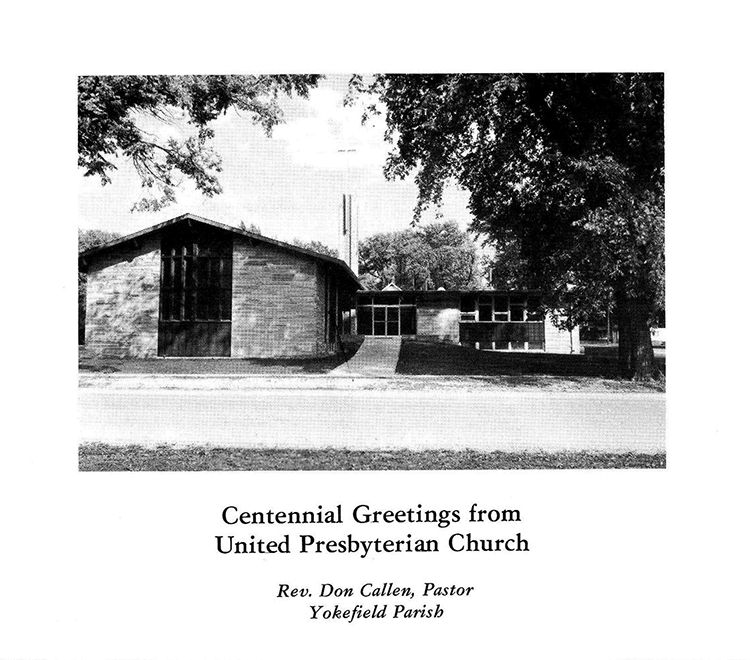

152
A glimpse into the past...
Farm Operations
down on the farm long long ago.
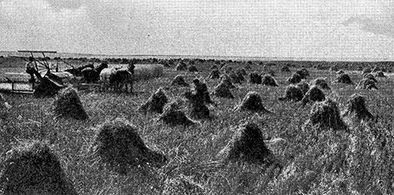 |
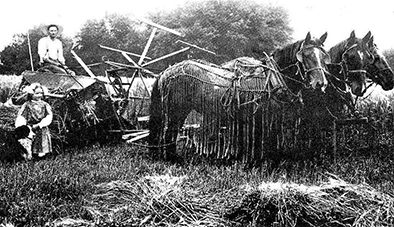 |
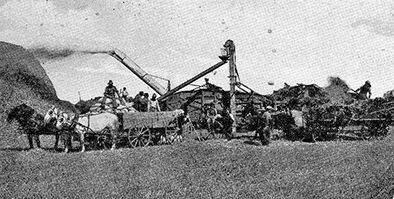
1913 |
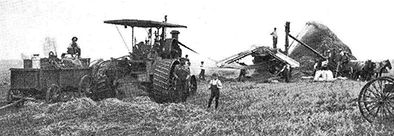
Threshing in the old days. |
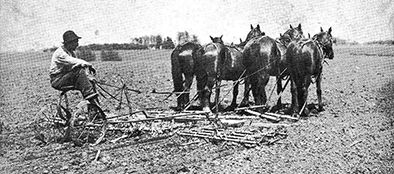 |
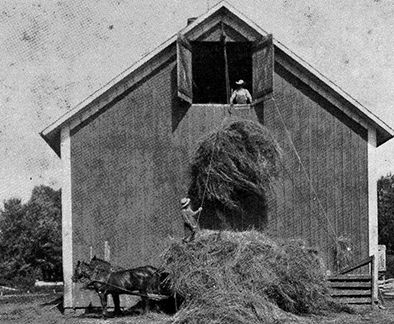 |
 |
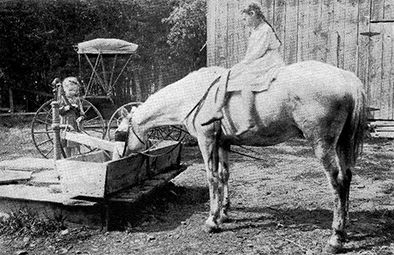
Irene Coffman, Tressis Coffman and George, the horse. |
 |
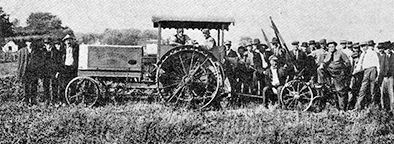
September 23, 1916. Tractor "burns kerosene, gasoline or motor
spirits". James Ralston, agent. |
153
A glimpse into the past...
Hybrid seed
companies were represented as well as other notable people; also Mr.
Casmer, representing radio station WMT, Cedar Rapids and Waterloo.
February 15,
1940. Gold Medals were awarded at Ames Monday to 141 growers of 100
bushels or more of corn in 1939 as certified by Keota Community Club.
All but 25 of these 141 are from Keota community.
October 17, 1940.
Here's a piece of history we'd like to forget. One of our friends sends
us a card mailed by Grain Bulletin at Minneapolis on Dec. 27, 1932, to
Powers Elevator Co. at Walum, N.D. Shell Corn Yellow—No. 2—4¢, No.
3—3¢, No. 4—2¢, No. 5—0¢, Earn corn 2¢ less. Cheap 1931 corn pushed
hogs down to as low as $2.40 on Iowa farms. Nobody knows what cheap
1932 corn would have done to 1933 hog prices if no federal action had
been taken. — Iowa Homestead.
December 12,
1940. Corn is being sealed at the rate of 61¢ a bushel.
September 4,
1941. Keota Community has 3-year record for tallest corn. In 1939 Don
Radda of 11 miles east of Keota had the tallest stalk—23 feet 10 5/8
inches. The stalk didn't have a mature ear; so, it was disqualified. W.
P. Greiner won third prize. In 1940 Don Radda won sweepstakes with a
stalk 19 feet 8 3/4 inches. In 1941 Lawrence Flander won with a stalk
23 feet 2 1/2 inches. He was awarded WHO Iowa State Fair Tall Corn
Sweepstakes. He won $100 in cash, Col. B. J. Palmer gold trophy, and an
Oliver plowmaster plow valued at $116.85.
February 15,
1945. Doyle Palmer, 40, is the new soybean king for Iowa. Doyle's
record was 37.59 bushel per acre in official five-acre contest. The
contest is sponsored locally by Keota High School FFA and agricultural
department.
In 1961 Mr. M. E.
Dillon was winner of the State Contour Contest, third year in a row.
The yield was 157.1 bushels.
The Keota area
churches have contributed 395 bushels of com and $280.00 to the Keokuk
County Corn Drive for 1961. This CROP contribution was the largest for
any equal sized territory in the county.
In 1968 the
"swamp-buggy" type vehicle was introduced into the Keota community. The
new piece of equipment was used for the purpose of spraying liquid
fertilizer and herbicides. It rides on top of wet and spongy ground
without sinking in. The three airplane-type tires cost $1,000.00 each.
It has been noted
that the finest corn land in Keokuk and Washington counties brought
only 30¢ an acre 136 years ago when Uncle Sam bought it from the
Indians, compared with $800 to over $1,000 per acre which land has been
bringing in the 1972-1973 period, in the same area.
REMEMBER 1936?
Here are some
temperatures which were experienced in 1936 around Keota:
July, 1936
4 - 107
5 - 110
6 - 104
7 - 105
8 - 105
11 - 111
12 - 111 (Hot wind)
13 - 111
14 - 112
15 - 110
16 - over 100
17 - over 100
22 - 100
25 - 105
26 - 110
August, 1936
9 - 104
12 - 103
14 - 108
15 - 100
18 - 110 (Hot wind)
24 - 104
**********
February 15,
1917. This is the day of the Singmaster sale of horses and perhaps the
town has never seen as large a crowd of strangers in its history as are
here today. Both hotels are full and private rooms have been secured.
The ladies of St. Mary's served dinner in the Singmaster building on
West Broadway.
Forty-nine
Percherons were sold for $32,000 and were shipped out next day. As one
viewed the crowd it was easy to realize that it has been the
Singmasters and their fame as importers that has put Keota on the map
and made it known in almost every corner of this and other nations.
**********
February 18,
1898. The old Black Hawk Mill on the Skunk River below Harper is being
torn down. It was one of the land marks of this section of country but
we suppose its day of usefulness has passed and it needs must go the
inevitable way of all things on earth.
*********
May 23, 1968.
Ruby Helscher found a note in her family bible stating that on May 23,
1882, it snowed two inches in Keota. It was signed by J. L. Ramsey,
former mayor of Keota. He was Ruby's grandfather.
November 11,
1971. W. C. Gretter and Sons of Harper are dumping excess corn on the
ground. They have about 72,000 bushel on the street. It's a lot of corn
and worth a trip to see it.
154

155
A glimpse into the past...
A HUNDRED YEARS OF EDUCATION
District
Number
Seven was organized as the "Independent School District of East
Lafayette Township" in March, 1873, by a vote of Lafayette Township.
(This school was located at the intersection near the Alva Bohrofen
home.) On March 10, 1873, a meeting of the electors of the district was
held in the schoolhouse for the purpose of electing officers according
to law. William McLoud was Chairman and H. P. Newton secretary of the
meeting. The officers elected were: R. T. Carris, President of the
Board of Directors; H. P. Newton, Secretary; H. N. Newton, Treasurer;
William Mcloud, Isaac Schreckengast and Howard Case, Directors. The
following electors were present: Howard Case, Perry Fulton, Henry
Fulton, H. N. Newton, William Mcloud, J. J. Forbes, H. P. Newton, T. F.
Jones, R. T. Carris. The name, Independent District of East Lafayette,
was established by vote.
The
following
July 17, 1873, a special meeting of this Board was held at the school
house with these members present: President R. T. Carris, H. P. Newton,
H. Case and I. Schreckengast. A petition was presented to the Board
asking that the new town of Keota (laid out in 1872) be set off as an
independent school district with boundaries as follows: Commencing at
the S.E. Corner of section 24, Township 76, range 10 west, running
thence north one-half mile, thence west one mile, thence south one
mile, thence east one mile thence north to place of beginning. The
petition was signed by 19 residents of Keota.
On
motion it was
agreed to grant this request excepting as to territory which was
reduced with boundaries as follows: Commencing at the S.E. corner,
Section 24, running thence south one-half mile, thence west one mile,
thence south one-half mile, thence west one mile, thence east one mile
thence north to place of beginning. It was moved and carried that an
election should be held of the voters of said territory "to determine
whether they will be set off or not," said election to be held at the
store room of J. S. Kulp on the 27th day of July, 1873, polls to be
open from nine a.m. to 12 m. [sic]
A
special meeting
of the Board of the Independent District of East Lafayette was held at
the hardware store of J. S. Kulp in Keota on the 18th day of July,
1873, with these members present: William Mcloud, I. Schreckengast and
H. Case. The President being absent H. Case was elected as President
Pro-tem. The meeting was called to consider the action of the Board in
regard to the boundaries of proposed Independent District of Keota. On
motion of I. Schreckengast the following boundaries were established:
Commencing at the S.E. corner of Section 24, Township 76, Range 10,
west, running thence north 1/4 mile, then west one mile, thence south
1/2 mile, then east one half mile, thence north to place of beginning.
On motion the date of the election was changed to July 31.
On
September 23,
1873, a special meeting of the Directors of the Independent District of
East Lafayette and the board of the newly established Independent
District of the Town of Keota, Iowa, was held in the store of J. S.
Kulp. Those present were: President, R. T. Carris; Secretary, H. P.
Newton; Directors McLoud, Schreckengast and Case for East Lafayette;
President R. S. Brice; Secretary, J. F. Graham; Directors J. S. Rice,
J. S. Kulp and J. F. Wilson for the Independent District of Keota. The
meeting was called for a purpose of a settlement between the said
districts. After considerable discussion it was agreed that the
Independent District of East Lafayette retain all the assets and assume
all liabilities of the Independent District of East Lafayette. It was
ordered by the Board of East Lafayette that the secretary inform the
County Auditor that the levy was to be cut in half, making $250.00 as
teachers fund and $75 for contingent fund. The meeting adjourned and
the "Independent District of Keota" was established and on its own. The
J. S. Kulp hardware store was located on the corner of Broadway and
Fulton Streets at the location where later a Bank building was erected
and now (1973) the offices of Dr. Don.
KEOTA'S
FIRST SCHOOL
The
first school
taught in Keota was a private one and was taught by Mrs. M. E. Smock in
what was then known as Smock's Hall. The first public school was taught
by A. E. Spalding and its sessions were held in what was then the
lumber office of H. Henkle.
In
1874 bonds
were is sued to the amount of $2,200 and the two north rooms of the
first school building were erected. In 1876, more school facilities
being demanded, $1,800 school bonds were issued and the wing to the
south containing two rooms was built. The school then consisted of four
rooms and four teachers. During 1888 additional bonds were is sued to
build an annex on to the south. The school now consisted of six school
rooms and six teachers. The enrollment was 203 pupils. The school board
then consisted of J. L. Ramsey, M. A. Crawford, R. S. Brice, A. L.
Erdice, H. Henkle and W. R. Charlton. Quoting from The Keota Eagle of
May 11, 1888, "We feel proud of our schools, glad the community is
composed of people who take a great interest in educational matters,
glad that the pupils themselves are anxious and pleased to derive the
benefits from a good school." The school grounds comprise five lots 66
x 150 each, which were neatly fenced.
In
1881 Professor
Wright succeeded J. W. Blythin as head of the school system and to him
and a good school board was credited with an excellent school system
which was known far and wide. It was Mr. Wright who was responsible for
getting the school graded into a 10-year course and at the end of which
time graduated the first class from the Keota Schools in 1882. The
exercises were held in the Creamery Hall. Mrs. A. A. Hulse and Mrs.
Clara Bower were members of this class and there were probably others.
In
May 1883
Commencement exercises of the Keota School were held in the Opera
House. There were two graduates: Eva M. Reed and Eben J. Ramsey. The
tickets were put on sale on Monday morning at the Post Office. Reserved
seats being 20¢. By the time of exercises on Thursday all tickets were
taken. Many who came without tickets had to go away without gaining
admission.
A
"Teacher's
Association" of this township was formed in February 1885 and held
their first meeting in Harper. "A big crowd was present and Keota was
well represented. Butler Schrecken gast and A. L. Eckley discussed the
subject of compulsory education in the United States."
156
A glimpse into the
past...
February
17,
1888. The High School pupils have organized a reading circle. They are
devoting their attention to English class literature. This is a move in
the right direction.
March
30, 1888.
While our school tax is the heaviest we are called on to pay, it is an
interest near our hearts. We wish our children to have a good
education. This means under our graded system — 12 school years of
eight months each and if children attend regularly they should by 17
years be well fitted for "life's earnest battle."
January
9, 1891.
The Keota High School Alumni Association is the name of the
organization formed by ex-graduates at a meeting held January 2.
Officers as follows: E. J. Ramsey, President; Nora Gwin, Secretary; J.
L. Papes, E. A. Kreger, Historians. Intention of the society is to have
two meetings each year—one during the holidays and another the night
before each Commencement.
January
10, 1896.
Principal McKee canvassed the school rooms and found material or books
used much behind the times—as—Reader, 18 years; Arithmetic, 20 years,
being copyrighted 1876; Grammars, 28 years; Spellers in 2nd and 3rd and
4th rooms, 17 years. High School Spellers, 13 years. This is serious
and one which parents should give due consideration. December 20, 1900.
A recent act of the United States Senate Committee, who made an
investigation of the Public Schools, brought a change in the present
order of things and a basis of common sense was established concerning
"home study." "Children 12 years and under are forbidden to study at
home." "Medical science has determined that undue mental strain retards
proper physical development of the growing child."
October
17, 1901.
Lovers of the game of football met and affected an organization and
will be prepared hereafter to meet all comers in a gridiron way. F.
Stewart is Captain-Manager and W. C. Farmer is Coach. The first contest
will be at Keota Park, Saturday, October 26.
February
3, 1903.
The launching of the "Keokuk County Athletic Association" was
accomplished by half a dozen school principals of the county at What
Cheer. The object of the organization is to create a clean and
wholesome spirit for athletics and a friendly rivalry among the schools
of the county.
April
2, 1903.
The first basketball game of the season was played at the park Monday
evening.
May
7, 1903.
Keota sent a splendid delegation to the first annual field meet of the
Keokuk County High School Athletic Association at What Cheer. The day
was cold and dark, but nothing short of a waterspout can dampen the
enthusiasm of a Keota crowd when it gets its blood up. Keota had by far
the strongest all-around team leaving its rival Keswick far in the
rear. There were 15 events and Keota won 50 points. Five schools were
entered: Keota, Keswick, Thornburg, Delta and What Cheer. Some of Keota
stars were: Roy Shotts, Eugene Smith, Ray Stewart and Vernon Carris.
May
21, 1903. At
the field meet of the Keota Athletic Association held at the park,
additional Keota stars are: Bert McDowell, Howard Stewart, Clarence
Pool, Harry Helscher and Roy Neal.
December
17,
1903. The School Board held a meeting and appointed Marshall J. W.
Richardson as "truant officer." It came to the Board's ears that a
number of children in Keota are not attending school. Law says that all
children up to 14 years must attend school.
It
was during the
Christmas vacation Monday afternoon, December 30, 1907, that it was
noticed that smoke was issuing from the upper windows of the school
house. The fire department was quick to respond but in an hour's time
the chimney was all that was left.
Classes
were held
in various places about town: the town hall, the high room in the Post
Office, Miss Kites' room in the rear of the Post Office, band room and
the Stoutner building. The School Board immediately took steps to draw
plans and specifications for a new school.
The
new Keota
School building opened for use Monday, January 18, 1909.
HISTORY
OF ACHIEVEMENT
Old
building
burned December 30, 1907. The Board arranged for classes to be held in
different rooms around town and then gave attention to a new building.
O. H. Carpenter was selected as architect—contract let May 13, 1908, to
Concrete Engineering Company of Davenport and heating and plumbing to
Wilson Heating Company of Washington, Iowa. The outside walls are of
brick and stone backed with hollow hard burned blocks. The floor is
re-inforced concrete with hollow block fillers. Stairs are re-inforced
concrete with iron railings. Direct and indirect systems of heat are
used. The first floor has the superintendent's office and five class
rooms. The second floor is divided into two class rooms, three
recitation rooms and assembly room (which will seat 130 pupils and in
case of a small entertainment - will seat 300 people) with 14 foot
ceiling. Main dimensions are 67 x 89 feet. The Howard tower clock was
donated by citizens of Keota.
During
the day
dinner lunches, candy, popcorn, etc., was sold in the basement by high
school pupils to aid the piano fund.
The Board of
Education should be complimented for its faithful and efficient work.
We
must not
forget our former Boards either, for the men who erected the first
school building in town may have had more to overcome than the present
Board.
PROGRAM
FOR SCHOOL DEDICATION
January
14, 1909.
The students of the Keota Public School will assemble in their
respective rooms in the new building at nine o'clock the morning of
January 18. The seats will be assigned, lessons and etc., and teachers
will read the rules and regulations prescribed by the Board. From one
o'clock to five o'clock the people are cordially invited as guests and
will be met by members of the Board and the teachers, assisted by the
ushers. The exercises are to begin at two o'clock in the high school
assembly room. The following program will be given:
157
A glimpse into the
past...
Music — Keota High School
Orchestra
Invocation — Rev. J. F. Robertson
Music — Male Quartet - F. G.
Henness, A. Clendenning, Sid
McDonald, W. R Hill
Story of Achievement — President
of Board
Address — Dr. E. A. Schell who is
President of Iowa
Wesleyan
A Word from County Superintendent
— H. S. McVicker
Greetings from Superintendent —
Cap E. Miller
Music — Male Quartet
The "Common Schools" — S. S.
Wright
The Keota School Corporation in
"History and
Reminiscence"
Dr. R S. Brice — First President
J. Fletcher Graham — First
Secretary
F. M. Smock — First Treasurer
John Randolph — Former Director
Music — High School Orchestra
Benediction — Rev. A. L. Graham
THE
TOWER CLOCK
A
tower clock for
the new school was decided upon. The district put up the tower which
cost $375 and Mr. C. F. Singrnaster's committee agreed to install a
clock with its steel bell. The tower was 12 feet square and about 26
feet above the roof. The clock had four six-foot dials, six feet in
diameter and a pendulum nine feet long with bell that was to be heard
all over town.
May
18, 1911. On
recommendation of the State Inspector of schools we were placed on the
accredited list.
January
23, 1912.
The W.R.C. ladies served a three-course banquet to teachers of the high
room and most of the high school pupils Saturday night along with
several alumni and Rev. Dorreen, coach of the 1912 football teams.
Various toasts were given and after Professor Neveln's toast, he
awarded each member of the 1912 football team a letter "K" of felt.
These letters for which they were greatly indebted to Harold Page
represent an honorable football career in the year of 1912.
May
29, 1913. The
school board voted to introduce Manual Training into our schools.
According to law we would have to do it by 1915 anyway.
December
31,
1914. The school board has purchased fine domestic science equipment.
It consists of six fine tables, each table to have two burners, so that
12 students can be accommodated at once. There is a machine which
supplies the gas heat. It is expensive—$307.80 installed. A room in the
school house must be gotten in readiness.
March
5, 1914.
The high school girls met Tuesday after school and organized the Girls
Athletic Association. Officers are: President, Eva Page; Vice
President, Isabelle Walker, Secretary and Treasurer, Lila Kracaw.
The
boys also met
and elected officers: Leland Page, Captain-Track Team; Evard Bower,
Captain-Ball Team.
1921.
The high
school has rented the hall above the Post Office (1973, the Laundromat)
in which to play basketball.
October
5, 1922.
The Keota Public School has a new outdoor drinking fountain at the west
entrance. The fountain was paid for out of the proceeds of the 1920 and
1921 class plays and is inscribed in honor of those two classes. It is
a practical and fitting memorial to those two classes.
October
18, 1923.
Did you know your school has an enrollment of 274 pupils? It has 12
teachers with an average of 23 to a teacher. It has the largest
Freshman class that we have records of going back to the time the
school house burned.
December
2, 1926.
Keota has the Champion Football team of Keokuk County. The 1926 team is
the best Keota has had to date. Mr. Landess is their coach.
May
19, 1927.
Keota High School has won two of the county's three athletic events.
Last fall they won the county football championship and last Saturday
won the county track and field meet.
October
6, 1927.
The new gymnasium-auditorium of Keota High School was completed several
weeks ago and was dedicated October 5 by Governor John Hamill. The
building was authorized by the voters of the School District of Keota
in the spring of 1926. It was built by W. L. Schragg of St. Joseph,
Missouri. Architects were Dougher, Rich and Woodburn of Des Moines. The
total cost was $75,000. The upper story encloses the high school
assembly room, library, physics laboratory and several class rooms. The
first story and basement form the high-ceiling gymnasium and
auditorium. At the east end there is a huge stage complete to the last
detail and four dressing rooms. The main floor is equipped for use as a
basketball floor and gymnasium and will seat 700 persons. Movable seats
are loaded on trucks and stored under the state. The balcony runs
around three sides and has opera-type seats which will seat 205 people.
At the rear are several smaller rooms, including a fire-proof
projection room. Entrance to the building is from the west. The brick
used in the new building is almost a perfect match to the old building.
The dedication exercises were in charge of the Alumni Association. The
bronze tablet, to which 200 Alumni contributed $1 each, has been placed
in the auditorium by L. B. Lupton of Washington and will be unveiled at
the dedication.
April
9, 1931.
Kindergarten will be started Monday, April 13, for all children living
in or near Keota, who will reach their fifth birthday in September of
this year. Miss Eula Moore will be the teacher. The morning sessions
will begin at 11 o'clock and will run until noon each day. Ten children
enjoyed the first kindergarten.
November
12,
1931. Keota High will issue its first Annual. Editor-in-chief, Olga
Valenta; Assistant Editors, Robert McNurien and Helen Kirkpatrick;
Business Manager, Victor Hess.
November
17,
1938. The Student Council originated in 1927 with the first meeting on
November 20. Mr. Moser put forth the purpose of organization and a
constitution was drawn up. Purpose is to afford a better means of
co-operation between teachers and students of Keota High School. All
problems and actions arising before the student body are discussed and
determined by the Council.
158
A glimpse into the
past...
The
President
must be a senior, the Vice-President a junior and a Secretary-Treasurer
who is a senior. The Legislative Body consists of one other junior, two
sophomores and two freshmen--the latter to be chosen by their classes.
The advisory is the Superintendent; executive officers are elected by
the student body.
December
15,
1938. Nearly a thousand attended the KeWash Jamboree—all six conference
teams were represented. There was an 85-piece massed band and a
basketball game between the teams which were grouped to represent the
North and South divisions of the conference.
August
7, 1941.
The new vocational home-making department in Keota High School will
consist of three rooms on the second floor, three kitchen units in one
room, a living and dining room and a sewing and study room. The kitchen
has been furnished with stoves, refrigerator, sinks, serving centers,
built-in cupboards and work areas. Maple furniture has been purchased
for other rooms and the walls repainted. Selection of drapes, linens
and china will be selected by girls in the classes this fall. The new
homemaking course is to be taught by Miss Virginia Herrick.
October
1, 1942.
The Keota Community's first annual FFA Community Fair, sponsored by the
Community Club and FFA students of the Agriculture Department of Keota
High School, will be held October 9 at the Gilbert addition, west of
the city park. There will be exhibits of livestock and judging, a
basket lunch at noon, band concerts, various races, milking contests
during the day. In the evening awards will be given to Fair
winners—husband calling, rolling pin throwing, songs by Home Town
Quartet, and an auction to sell War Bonds. Farmers are asked to donate
chickens, ducks, or whatever they wish. Bingo and other concessions
will be on hand. Prizes will be War Bonds and stamps. Finally there
will be an old time pavement dance. Each store will have antiques or
hobby displays.
April
25, 1946.
The question of whether the Keota Independent School District would
establish bus routes to serve rural districts of the community has been
decided. Two new buses, each with a capacity of 36 and 42 pupils have
been ordered through local dealers and an Indiana builder of school bus
bodies. Five rural districts in four townships will send pupils to
Keota School makes it necessary to buy buses. The school has rented the
Mound garage in the business district for the two school buses when
they are not in [sic]
KEOTA
KLIPPER
February
19,
1920. Number One — Volume One of the Keota Klipper, a newspaper issued
by the Senior Class of the Keota High School, made its appearance
Monday, February 16, and has made quite a hit. It is four pages — three
columns in width by ten inches in length, and carries about 50 inches
of local advertising — sold at 30 cents an inch. Subscription rates are
five cents a copy or 75 cents until first of June. Harold Russell is
business manager. The rest of the staff consists of Eva Blattner, Mary
Gregory, Gertrude Hagist, John Ralston, Will Fitzgerald and Harry
Brock.
September
23,
1920. The first Klipper of the new year appeared Monday noon at the
High School. It is $1.00 a year and single copies 10 cents. Raymond
Thompson is editor and Gilbert Adams manager. Twenty-two Keota firms
are supporting the paper with their ads.
November
2, 1922.
The Klipper, High School paper, starts its fourth year. Editors this
year are Thelma Kirkpatrick and Marjorie McCrabb. Keith Dayton is
business manager and reporters are Dwight Mound, Clarence Russell and
Ruth Ranous.
January
20, 1938.
The Keota Klipper has been published for about 18 years. It is one of
the very few printed school papers in southeastern Iowa and has
maintained the reputation of a good school paper. The depression of the
early 30's left a financial deficit and caused the printed Klipper to
become mimeographed. In this form the paper was a financial success,
but it didn't seem to satisfy those who were acquainted with the
earlier paper. Sentiment of the students and business men was found to
favor the renewal of the printed Klipper, and it was renewed in 1936.
It
seems that the
Klipper is now faced with the problem of either increasing the
circulation or raising the price of ads in order to make it financially
sound. The price increase in ads and subscriptions is questionable,
consequently, new moves to stabilize the paper are under consideration.
The
most drastic
change would be to cease the printing of an individual Klipper. In its
stead would be a page, or portion of a page, in The Keota Eagle. This
would remove all necessity of selling ads and student subscriptions.

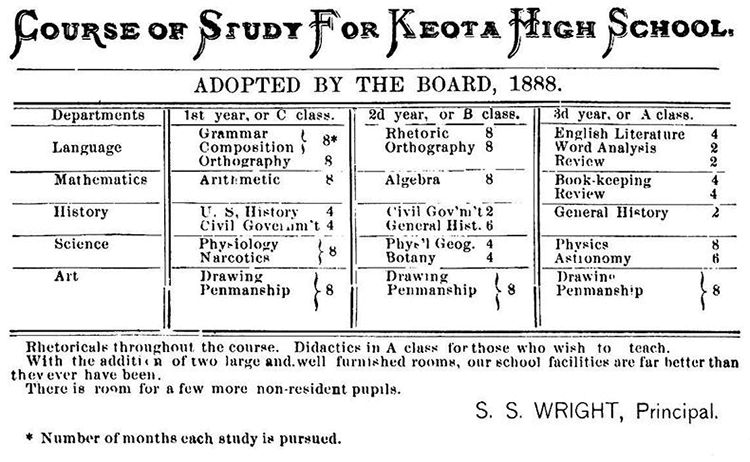
159
A glimpse into the
past...

First Commencement Exercises Program of Keota High School, 1883.
FUTURE
FARMERS OF AMERICA
The
Future
Farmers of America was organized in November of 1928. The organization
is built around leadership, character development, sportsmanship,
cooperation, service, thrift, scholarship, improved agriculture,
organized recreation, citizenship, and patriotism. The organization is
dependent upon cooperative spirit and a desire on the part of students,
14 to 21 years of age, preparing for a career in agriculture, through
vocational agriculture. National headquarters for the FFA is located in
Washington, D. C., in the Division of Vocational and Technical
Education.
The
Keota Chapter
of Future Farmers of America was started on February 1, 1943. The new
chapter was chartered with 20 members including: Roger Romine,
President; Mark Helscher, Treas., Eugene Reed, Vice Pres.; Leo
Ollinger, Sec.; Harold Fink, Reporter; Kenneth Pepper, Merle Miller,
Eugene Vogel, Roger Pepper, Robert Dill, Bill Hamilton, Keith Wehr,
Richard Winegarden, Russell Greiner, Charles White, Lyle Palmer, Gerald
Fosdick, Ted Watts, Cletus Reed, Lavern Weaver, David Wright, Donald
Hahn, Walter Ferguson, Harry Baumert, Bob Stewart, Dennie Hammen, Dean
Trier, Leonard Buch, Keith Buch, David Fladung, Robert Sieren, Jim
Henderson, Raymond Myers, Lloyd Peiffer.
The
chapter is
built around a program of activities which include community service,
and a supervised farming contest. Keota's FFA chapter involves students
in farming and other agriculture-related business. Involving students
includes renting land where members perform the duties of actual
farming and cooperating with business to help students acquire the
duties and job training of a agriculture related business.
One
of their
projects is renting ten acres of ground which is used for the
production of a corn crop. The actual use of different practices used
in farming are experimented with and used to their greatest efficiency.
Actual farming gives the members of the FFA practical experience in
planting, plowing, and harvesting the crop. All decisions are made by
the FFA with the advice of the adviser. Funk's G 304 Bushel Challenge
is a contest sponsored by Funk's G to promote high yields in corn by
FFA Chapters. The Chapter must plan accordingly in applying fertilizer
and planting corn population to produce the highest yields possible.
They try to meet the challenge of producing a record-breaking yield.
Each
year in the
fall they sell fruit to the community to have for the Christmas season.
This has been an annual project since 1968. The money earned from the
fruit sales is used to sponsor the Parents and Sons Banquet and other
FFA activities. The banquet is an annual event held in February or
March. It is held to honor all parents, outstanding FFA members, and
individuals who have done a great deal for the betterment of the FFA
Chapter. Some of the awards are Honorary Chapter Farmer, Star Chapter
Farmer, Star
160
|